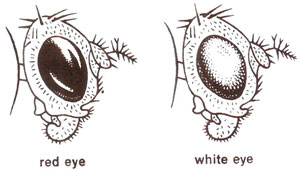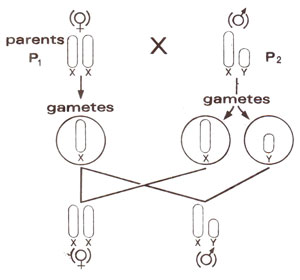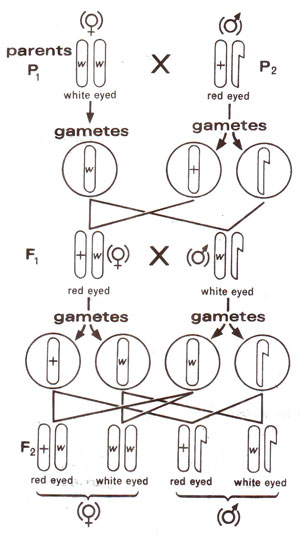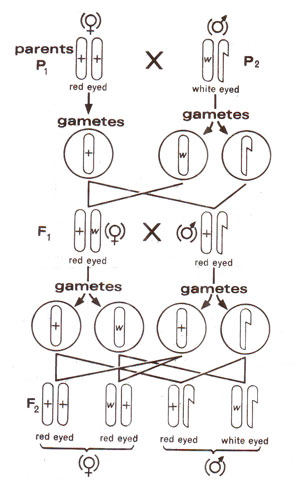Sex linkage in Drosophila
In Drosophila, man and other similar unisexual organisms, a pair of sex chromosomes is found. In the male individuals, this pair is heteromorphic (XY) involving one X-chromosome and one Y-chromosome, while in female it is homomorphic (XX) with two X-chromosomes (Fig. 16.2). In birds, however, the situation is reverse, the females having the heteromorphic pair of sex chromosomes (called ZW in order to differentiate it from XY male heteromorphic) and males having the homomorphic pair (ZZ).
Consequently, if female parent carries recessive character in homozygous condition and male parent carries dominant allele, female individuals in F1 generation will always show dominant phenotype (heterozygous), and male individuals will show only recessive phenotype in this generation (F1). If intercrossing is now allowed among individual from F1 generation, it would be seen that iriheritance with respect to sex is of a crisscross type (Fig. 16.4). A character from father goes to daughter (F1) and then from daughter to grandson in the next generation (F2).
White eyed ♀ x red eyed ♂. In Drosophila, white eye colour is recessive to normal red eye colour. If white eyed female individual is crossed to red eyed male individual, all female individuals in F1 generation are red eyed and all male individuals are white eyed. When these red eyed female individuals and white eyed male individuals from F1 generation are intercrossed, female population in F2 generation will consist of 50% red eyed and 50% white eyed individuals. Similarly, in the male population in this generation, 50% offspring would be red eyed and 50% white eyed (Fig. 16.5).
Red eyed ♀x white eyed ♂. When red eyed female individual is crossed with white eyed male individual, male as well as female individuals in F1 generation would be red eyed. In F2 generation in this cross, female individuals would be exclusively red eyed but in male population (F2), 50% individuals would be red eyed and 50% white eyed (Fig. 16.6).

Fig. 16.2. Somatic chromosomes of female (2n = 8 = 6 + XX) and male (2n = 8 = 6 + XY) Drosophila flies.









